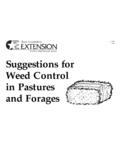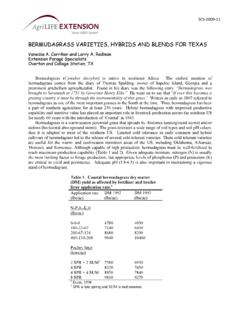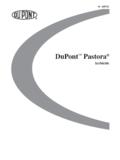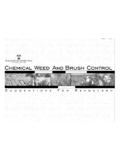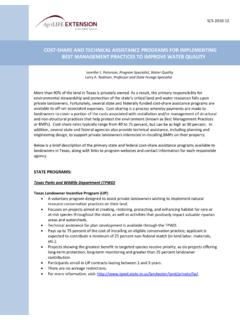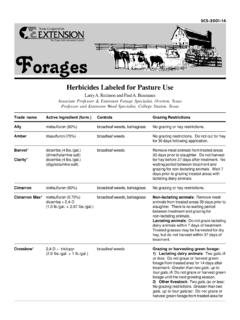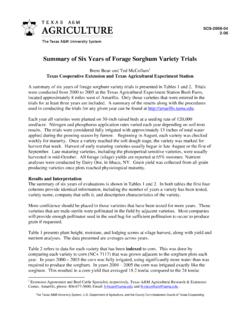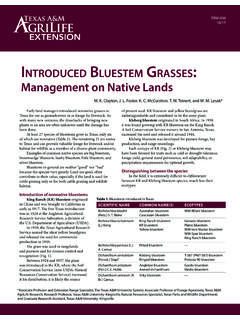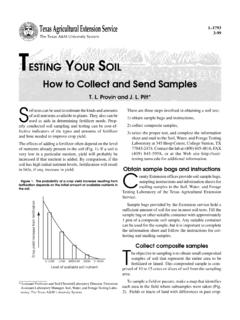Transcription of Forages
1 ForagesSCS-2002-14 Forages for TexasLarry A. Redmon**Extension forage Specialist, Texas A&M University Research and ExtensionCenter, Overton, TexasForage and forage -based livestock production enterprises arebig business in the US. Latest available USDA statistics (2001)indicate hay harvested in the US was worth approximately$ billion. This made hay second in overall value amongagricultural crops grown in the Only corn ($ billion)exceeded the value of hay (Table 1). The value of all cowsand calves in 2000 was estimated at approximately $72 billionwith the gross income from beef cattle estimated at $36 billionthat same 1. Value of commondities produced in the ($)Barley535,472,000 Corn19,209,312,000 Cotton3,383,732,000 Cows and calves41,128,150,000 Hay12,611,560,000 Rice895,757,000 Rye20,243,000 Soybeans12,439,597,000 Sugarbeets/sugarcane2,054,821,000 Tobacco1,916,234,000 Wheat5,553,815,0001 All values are based on 2001 statistics except for cows and calvesand sugarbeets/sugarcane (2000)Source: USDA National Agricultural Statistic 40% of the total cowherd is contained in 14southern states (Table 2).
2 Likewise, much of the hay producedalso comes from these same states. It should be obvious,then, that Forages play a major role in the economies of thesestates. While warm-season perennial grasses provide the baseon which most operations are based, cool-season Forages alsoplay a significant role in both cow-calf and stocker calfproduction systems. The main species adapted for use asgrazeable Forages or hay crops in the South, with specialemphasis on Texas, will be discussed in the following GrassesBahiagrassBahiagrass (Paspalum notatum) is a warm-season perennial grassnative to South America. The first introduction to the in 1913 with common bahiagrass by the FloridaAgricultural Experiment Station. In 1935, Escambia CountyExtension Agent Ed Finlayson found a more productivebahiagrass growing along the docks and railroad tracks atPensacola, FL.
3 This variety became known as Pensacola andhas been the most widely used of all the varieties to date. Amore recent release from the USDA-ARS station at Tifton,Table 2. States comprising the US southern region, estimatednumber of cows and calves, and their estimated of headValue ($)Alabama1,360,000788,800,000 Arkansas1,810,0001,140,300,000 Florida1,800,0001,134,000,000 Georgia1,270,000800,100,000 Kentucky2,260,0001,469,000,000 Louisiana860,000533,200,000 Mississippi1,070,000631,300,000 Missouri4,250,0002,890,000,000 North Carolina950,000570,400,000 Oklahoma5,050,0003,232,000,000 South Carolina445,000280,350,000 Tennessee2,170,0001,302,000,000 Texas13,700,0008,357,000,000 Virginia1,650,0001,105,500, Total97,308,50070,552,530,000 Source: USDA National Agricultural Statistic Service, , Tifton 9 has exhibited increased seedling vigor andhigher dry matter production compared with value of Tifton 9 has been comparable has several characteristics that make it valuable as apasture grass.
4 Bahiagrass grows on a wider range of soilsthan does bermudagrass or dallisgrass. Compared with hy-brid bermudagrass, bahiagrass tends to green up earlier andremain green longer in the fall, but lacks the drought toler-ance of the bermudagrass on deep sandy soils. Bahiagrass isresistant to weed encroachment due to an extremely thicksod formed and tolerates close, continuous grazing betterthan most other grasses. The species also produces moderatelevels of dry matter on soils of very low fertility and, finally,is established from seed. Pensacola seedlings, however, mayexhibit poor vigor and establishment can be soil types range from upland sandy sites (on whichbahiagrass may suffer during summer drought) to more poorlydrained sandy areas. When establishing bahiagrass, seed shouldbe broadcast onto a well-prepared seedbed at 12 to 15 pure live seed per acre, covered with no more than one-half inch of soil, and rolled to ensure good seed-soil seeding rates can help to quicken establishment.
5 Es-tablishment usually takes place in the spring after the last chanceof a killing frost has occurred. Although the optimum tem-perature range for bahiagrass seed germination is 85 to 95 F,weed pressure is greater with later plantings and the relativelyweak bahiagrass seedlings are at a competitive any needed P and K and 30 to 40 of N atplanting. Additional nitrogen (N) will only serve to encour-age weed competition. After the grass begins to cover, 40 to60 of additional N may be used. Early weed man-agement involves mowing or limited mob grazing. The her-bicide 2,4-D may be used only after the grass reaches five tosix inches in height; use of phenoxy herbicides prior to thisstage may kill or injure the grass seedling. Once bahiagrassreaches a thick, solid stand, weeds are seldom a , bahiagrass should be fertilized according to soil testrecommendations, although even minimal amounts of N, P,and K will serve to increase dry matter production and crudeprotein should primarily be used for pasture, althoughsome is harvested and conserved as hay.
6 Producers used toharvesting bermudagrass hay should realize bahiagrass shouldbe cut at a much lower plant height (eight to ten inches) ifhigh levels of forage nutritive value are desired. If bahiagrassis cut for hay, it is critical to apply appropriate N, P, and Kbased on soil test recommendations due to the removal ofnutrients from the site. Given similar levels of fertility, hybridbermudagrass will usually provide more dry matter produc-tion and higher levels of crude protein and digestibility (Table3). Under low levels of fertility, bahiagrass, however, canpersist for many years in relatively pure stands. forage nutri-tive value is usually adequate for mature beef animals, butweaned growing animal performance may suffer if an ap-propriate supplement is not maximize use of the pasture and to help reduce winterfeeding costs, overseeding bahiagrass with a legume, smallgrain, or ryegrass may be advisable.
7 In the past, producershave perceived it difficult to establish cool-season pasture inbahiagrass. This is generally due to the thick layer of rhi-zomes produced by bahiagrass. In order to reduce bahiagrasscompetition, the pasture should be grazed close and lightlydisked. Clover or ryegrass seed should be broadcast some-time in mid-October. If using a cereal grain, a drill should beused to place the seed deeper. Note that although bahiagrasscan perform under low fertility programs, winter pasturespecies will not. Fertilizer should be applied at the recom-mended rate based on soil bahiagrass has many positive characteristics as apasture grass, it has its share of problems. Because the spe-cies can persist under lower fertility environments, many pro-ducers have witnessed an invasion of bahiagrass into theirbermudagrass fields. This is usually because fertility is lessthan optimum for the bermudagrass to prevent establishmentof the bahiagrass.
8 Once present, bahiagrass tends to remainand even become dominant in bermudagrass fields. Gener-ally, of the herbicide Cimarron (formally Ally) isrequired to eliminate mature plants. Without a change in fer-tility or grazing management, bahiagrass generally will re-es-tablish from seed the following 3. forage nutritive value of bahiagrass, bermudagrass,and mixed warm-season grass TypeProteinNutrientsFiber% DMBahiagrass Grass State UniversityBahiagrass establishment is slow and the species respondspoorly to N fertilizer rates above 100 Lower drymatter production compared with hybrid bermudagrass cancreate a need to decrease stocking rate. Likewise, lower for-age nutritive value decreases animal performance. These situ-ations reduce the potential for profit for those attempting tomaximize production per unit area of summarize, bahiagrass has a bad reputation, but only whencompared with well-managed bermudagrass.
9 Under more re-alistic circumstances of lower fertility and continuously stockedpastures, bahiagrass may not be so bad as a pasture on the goals and objectives for the particular prop-erty, bahiagrass may deserve more respect than it has receivedin the (Cynodon dactylon) probably originated insoutheast Africa. The earliest mention of bermudagrasscomes from the diary of Thomas Spalding, owner of SapeloeIsland, Georgia and a prominent antebellum in his diary was the following entry: Bermudagrass wasbrought to Savannah in 1751 by Governor Henry Ellis. He wenton to say that If ever this becomes a grazing country it must bethrough the instrumentality of this grass. Writers as early as 1807referred to bermudagrass as one of the most important grassesin the South at the time. Thus, bermudagrass has been a partof southern agriculture for at least 250 years.
10 Hybridbermudagrass with improved productive capability andnutritive value has played an important role in livestockproduction across the southern for nearly 60 years withthe introduction of Coastal in is a warm-season perennial grass that spreadsmainly by rhizomes (underground stems) and stolons(horizontal aboveground stems). The grass tolerates a widerange of soil types and soil pH values, thus making it adaptedto most of the southern Limited cold tolerance in earlycommon and hybrid cultivars of bermudagrass led to therelease of several cold-tolerant varieties, thus providing usefulwarm-season perennial grasses for the warm-season, cool-season transition areas of the , including Oklahoma,Arkansas, Missouri, and is generally planted on a well-prepared seedbedwith sprigs (stolons and rhizomes) of hybrid varieties at 25 to40 bushels of sprigs per acre. Seeded varieties are generallyseeded at 8 to 10 lbs.
